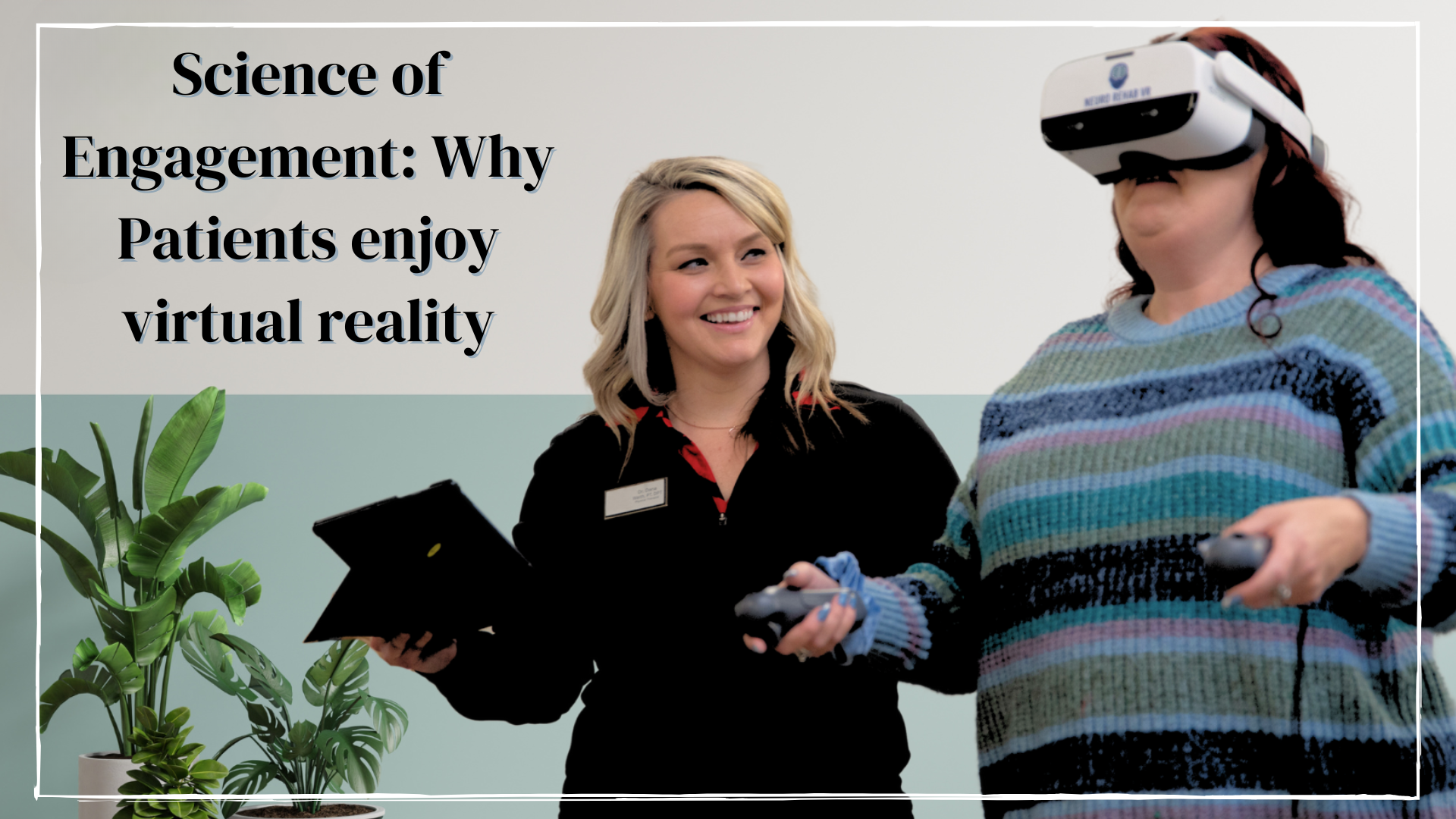Science of Engagement: Why Patients enjoy virtual reality
Written by: Brianna Hodge
Imagine stepping into a world where your rehabilitation journey feels less like a clinical routine and more like an immersive adventure. For many patients, traditional rehabilitation can be monotonous, challenging, and emotionally draining. But virtual reality (VR) therapy is changing that narrative. It's not just a trend—it's a scientifically-backed method that keeps patients engaged and committed to their recovery. So, what makes VR therapy so compelling? Let’s dive into the science of engagement and explore why patients stick with VR therapy.
The Psychology Behind Engagement in Therapy
At its core, engagement in therapy is about motivation. Studies show that when patients are motivated and actively participating, outcomes improve significantly (Deci & Ryan, 2000). Traditional rehabilitation often struggles to maintain this motivation due to repetitive and mundane exercises. VR therapy, on the other hand, taps into intrinsic motivation by offering immersive, interactive, and enjoyable experiences.
The Self-Determination Theory (SDT) highlights three key psychological needs: autonomy, competence, and relatedness. VR therapy addresses all three:
Autonomy: Patients choose tasks and control their pace.
Competence: Real-time feedback fosters skill mastery.
Relatedness: Multiplayer or therapist-guided scenarios build social connections.
By satisfying these needs, VR therapy creates an environment where patients are more likely to stay engaged and committed.
Neuroplasticity and the Brain’s Response to VR
One of the most fascinating aspects of VR therapy is its effect on neuroplasticity—the brain’s ability to reorganize itself by forming new neural connections. This is particularly critical for patients recovering from strokes, traumatic brain injuries, or neurological disorders.
A study published in Frontiers in Neurology found that VR-based rehabilitation significantly improves motor function in stroke patients by promoting brain plasticity (Laver et al., 2017). The immersive nature of VR allows patients to engage in repeated, task-specific exercises that are crucial for neural rewiring.
Moreover, the visual and sensory feedback provided by VR enhances motor learning and cognitive engagement. This continuous interaction not only accelerates physical recovery but also boosts mental well-being.
Real-Life Case Studies: The Impact of VR Therapy
One compelling example is a study conducted at the University of Southern California, where VR exposure therapy significantly reduced PTSD symptoms in veterans (Rizzo et al., 2014). The immersive VR environment allowed patients to confront and process traumatic memories in a controlled, supportive setting, leading to better long-term outcomes.
Another study is a randomized controlled pilot published in the Journal of NeuroEngineering and Rehabilitation evaluated the efficacy of virtual rehabilitation for stroke survivors. The study involved 21 adults with sub-acute stroke who were randomized to receive either four weeks of virtual rehabilitation combined with conventional therapy or conventional therapy alone. The system, utilizing customized surface computing and tangible interfaces, produced strong treatment effects for upper-limb and cognitive function. Participants receiving the combined therapy showed significant improvements in motor, cognitive, and functional outcomes compared to those undergoing standard rehabilitation alone. These findings suggest that integrating virtual rehabilitation technologies into conventional therapy can enhance recovery processes for stroke patients.
The Role of Gamification in Sustaining Interest
Gamification—the use of game design elements in non-game contexts—plays a pivotal role in patient engagement. VR therapy integrates gamified elements like rewards, progress tracking, and adaptive challenges to make rehabilitation more engaging.
Research from JMIR Serious Games highlights that gamified rehabilitation programs increase adherence and motivation among patients with chronic conditions (Li et al., 2016). By turning therapy into a game-like experience, patients are more likely to stick with their treatment plans.
For instance, VR games designed for balance training might involve navigating obstacle courses or collecting virtual objects. These challenges not only target physical rehabilitation goals but also stimulate cognitive functions, making therapy both fun and effective.
Pain Distraction and Emotional Engagement
Chronic pain is a significant barrier to therapy adherence. VR's immersive environments can effectively distract patients from pain, making therapy more tolerable. A study in Pain Management found that VR significantly reduced pain perception in burn victims during wound care procedures (Hoffman et al., 2011).
The ability to transport patients to calming, engaging environments reduces anxiety and stress, enhancing emotional well-being. This emotional engagement fosters a positive association with therapy, encouraging patients to continue their rehabilitation journey.
Neuro Rehab VR: Pioneering Patient Engagement
Neuro Rehab VR exemplifies how innovative VR solutions can revolutionize patient engagement. Their XR Therapy System offers personalized, immersive therapy experiences tailored to each patient’s unique needs. Whether it’s balance training, gait exercises, or cognitive rehabilitation, Neuro Rehab VR integrates evidence-based practices with cutting-edge technology.
The platform’s interactive scenarios allow therapists to adjust difficulty levels and provide real-time feedback, fostering a sense of progress and achievement. By combining gamification, task-specific training, and therapist-guided sessions, Neuro Rehab VR keeps patients motivated and engaged throughout their recovery.
Clinics using Neuro Rehab VR have reported increased patient adherence and faster recovery times. This success is rooted in the system’s ability to make therapy not only effective but also enjoyable.
The Future of VR Therapy Engagement
As technology evolves, so does the potential for VR therapy to engage patients even more deeply. The integration of artificial intelligence (AI) will enable even more personalized therapy plans, adapting in real-time to patient progress. Biofeedback sensors could further enhance the immersive experience by responding to physiological cues like heart rate and muscle tension.
Moreover, remote VR therapy is expanding access to care, allowing patients to continue their rehabilitation from home. This convenience reduces barriers to adherence and supports consistent engagement.
Conclusion
The science of engagement in VR therapy is a blend of psychological motivation, neuroplasticity, gamification, and emotional involvement. By addressing the core needs of autonomy, competence, and relatedness, VR therapy keeps patients motivated and committed to their recovery. Real-life case studies and research underscore its effectiveness in improving outcomes.
Neuro Rehab VR is at the forefront of this transformation, offering innovative solutions that make therapy engaging and effective. As technology continues to advance, the future of VR therapy promises even greater patient engagement and improved rehabilitation outcomes.
-
Deci, E. L., & Ryan, R. M. (2000). The "what" and "why" of goal pursuits: Human needs and the self-determination of behavior. Psychological Inquiry, 11(4), 227-268.
Hoffman, H. G., Patterson, D. R., Seibel, E. J., Soltani, M., Jewett-Leahy, L., & Sharar, S. R. (2011). Virtual reality pain control during burn wound debridement in the hydrotank. Pain Medicine, 12(7), 993-1001.
Laver, K. E., Lange, B., George, S., Deutsch, J. E., Saposnik, G., & Crotty, M. (2017). Virtual reality for stroke rehabilitation. Frontiers in Neurology, 8, 213.
Li, A., Montaño, Z., Chen, V. J., & Gold, J. I. (2016). Virtual reality and pain management: Current trends and future directions. Pain Management, 6(5), 509-519.
Rizzo, A. S., Reger, G., Gahm, G., Difede, J., & Rothbaum, B. O. (2014). Virtual reality exposure therapy for combat-related PTSD. PTSD Research Quarterly, 25(2), 1-10.
Journal of NeuroEngineering and Rehabilitation. (2019). Elements virtual rehabilitation improves motor, cognitive, and functional outcomes in adult stroke: evidence from a randomized controlled pilot study.






